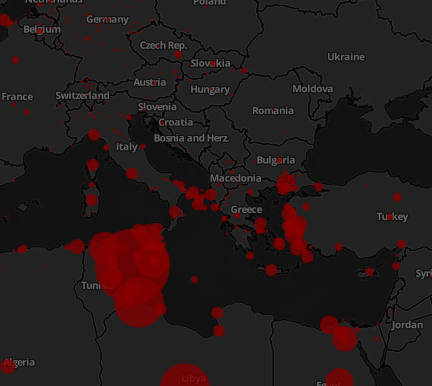The map above, created by a group of journalists for a project called The Migrant Files, depicts the number of migrants who died while trying to reach Europe between 2000 and 2013. The research conducted by the group reveals that 23,858 migrants lost their lives trying to reach Europe during that time – a number which is far higher than previously estimated. The researchers also warn that because of the disparity of some data sources, and the simple fact that some fatal incidents are never reported or documented at all, they believe their number to be a conservative estimate – many more could have died without anyone or any agency noticing.
In the shadowy world of transcontinental migration, shedding light on where and how would-be migrants lose their life is critical for better, more effective policy making. While many asylum seekers seek refugee status through formal pathways, an unknown number risk their lives by putting their fate in the hands of smugglers, or go it alone. Societies in conflict will always produce people with the urge to seek safety and a better life elsewhere. The EU has mostly adopted an approach that aims to protect their borders from irregular arrivals, through the monitoring and detection of the zones where would-be migrants typically pass through. As was reported in Le Monde Diplomatique, no agency in charge of security at Europe’s southern borders is documenting the loss of life related to irregular migration. An official for the European Agency for the Management of Operational Cooperation at the External Borders of the Member States of the European Union (also known as Frontex) told the Monde Diplomatique that the agency’s job was “to fight against illegal immigration, not rescuing people at sea. [Once] these people are dead, they are no longer migrants.”
The data collected by various organizations since the late 80s reveals that there has been a constant flow of people attempting to enter the EU through irregular means. And while the movement of goods and capital is made increasingly barrier-free within the EU, and between other countries, the free movement of people remains elusive. The difficulty of emigrating to Europe, for people hailing from poverty, war or conflict, will continue to push people into extreme situations, as the vast number of incidents reported by The Migrant Files shows. As long as the EU considers asylum seekers primarily as threats, and continues to erect barriers and treat irregular migrants as criminals, it is unlikely that this deeply disturbing death toll will wane.
The map shown above was originally created and published by The Migrant Files. Read more about the project here.
